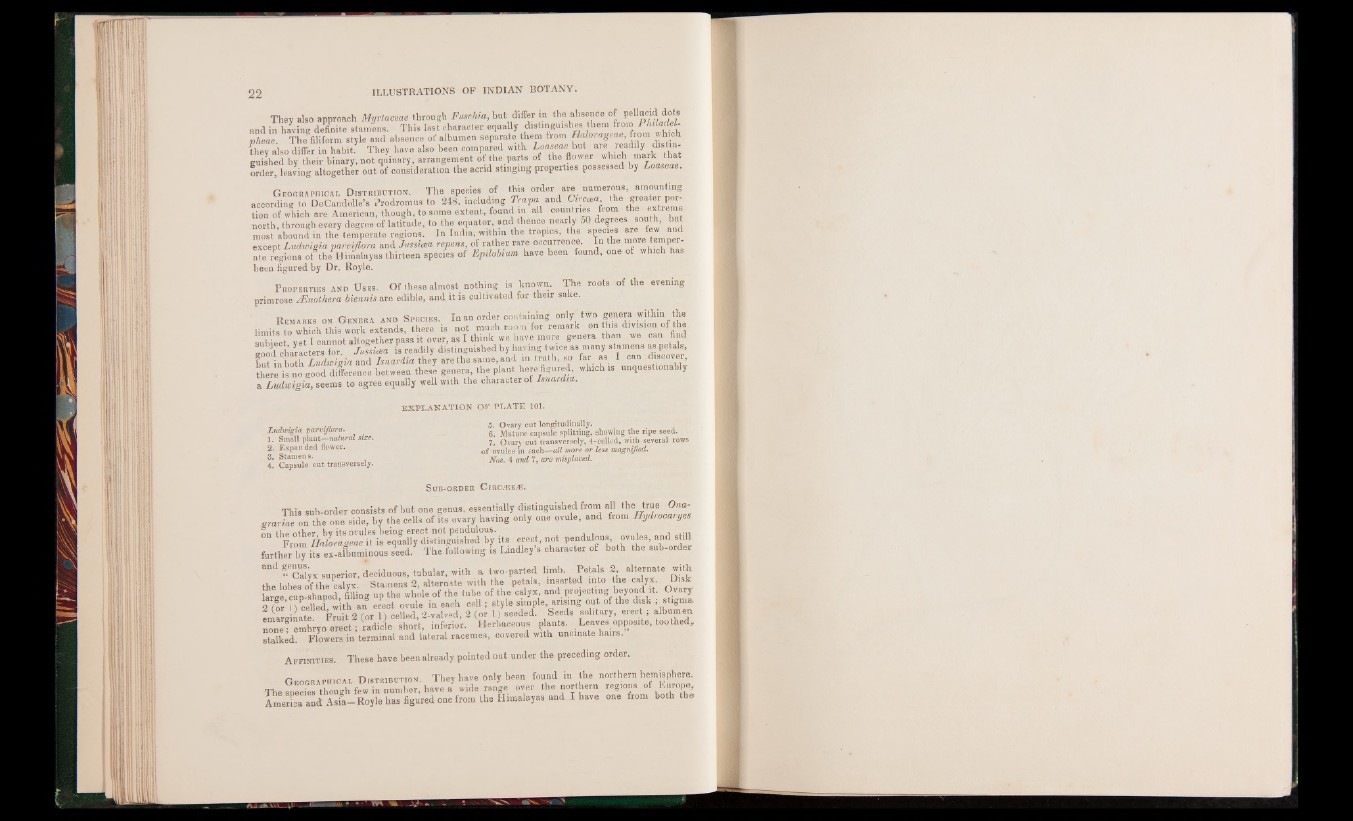
They also approach Myrtaceae through Fusohia, but differ in the absence of M B
and in having definite stamens. This last character equally distinguishes them from Philadel-
n/ieae. The filiform style and absence of albumen separate them from Halorageae, fi10m which
they also differ in habit. They have also been compared with Loaseaeibut are readily distinguished
by their binary, not quinary, arrangement of the parts of the flower which mark that
order, leaving altogether out of consideration the acrid stinging properties possessed by Loaseae.
G eographical D istr ibu t io n . The species of this order are numerous, amounting
according to DeCandolle’s Prodromes to 248, including Trapa
tion of which are American, though, to some extent, found in all countries from the e*tre™®
north, through every degree of latitude, to the equator, and thence nearly 50 degrees south, but
most abound8 i n t h l temperate regions. In India, within the tropics, the species are few and
except Ludwigia paniflora and Jussicea repens of rather rare occurrence. In the ™or® te“ Pe*-
ate regions of the Himalayas thirteen species of hpilobium have been found, one of which has
been figured by Dr. Royle.
P roperties a n d U ses. Of these almost nothing is known. The roots of the evening
primrose Mnothera biennis are edible, and it is cultivated for their sake.
R emarks on G enera a n d S pecies. In an order co n ta in in g o n ly ' tw o g en er a w ith in th e
lim its to w h ich th is work e x t e n d s , th e r e is n o t much r o om for remark on th is d iv is io n o f th e
subiect vet I cannot altogether pass it over, as I think we have more genera than we can find
Tood characters for. Jussicea is readily distinguished by having twice as many stamens as petals,
there is no good difference between these genera, the plant here figured, which is unquestionably
a Ludwigia, seems to agree equally well with the character of Isnardia.
EXPLANATION OF ELATE 101.
5. Ovary cut longitudinally.
6. Mature capsule splitting, showing the ripe seed.
7. Ovary cut transversely, 4-celled, with several rows
of ovules in each—all more or less magnified.
Nos. 4 and 7, are misplaced.
S ub-order C ir c l e .*.
Ludwigia parvifiora.
1. Small plant—natural size.
2. Expanded flower.
3. Stamen s.
4. Capsule cut transversely.
This sub-order consists of but one genus, essentially distinguished from all the tr“e ° na'
grariae on the one side, by the cells of its ovary having only one ovule, and from Hydiocaryes
on the other bv its ovules being erect not pendulous. . , ...
From Halorageae it is equally distinguished by its erect, not pendulous, ovules, and still
further by its ex-affmminous seed. The following is Lindley s character of both the sub-order
“ ^ ‘Ta ly x superior, deciduous, tubular, with a two-parted limb. Petals 2 alternate with
the lobes I t the oalyx. Stamens 2, alternate with the petals, inserted into the calyx. Disk
large cup-shaded filling up the whole of the tube of the calyx and projecting beyond it. Ovary
2 ffr’ h celledP w th an erect ovule in each cell; style simple, arising out of the disk ; stigma
emarginate.8 Fruit 2 (or 1) celled, 2-valved, 2 (or 1) seeded. Seeds solitary, erect; albumen
none? embiyo erect; radicle short, inferior. Herbaceous pants. Leaves opposite, toothed,
stalked. Flowers in terminal and lateral racemes, covered with uncinate hairs.
A ffinities. These have been already pointed out under the preceding order.
G eographical D istribution. They have only been found in the northern hemisphere.
The species though few in number, have a wide range over the northern regions of Kurope,
America and Asia—Royle has figured one from the Himalayas and I have one from both the